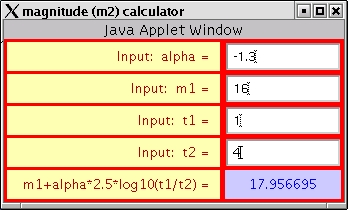Hypothetical example of "magnitude (m2) calculator" applet use...
- GRB 050123 was detected at 01:21 UT at RA(J2000)=07:30:21, DEC(J2000)=-30:32:21, with an error of 3'.
There is low reddening toward the burst.
- ANDICAM was alerted to the burst but was not able to observe the burst
coordinates immediately due to weather.
- In the meantime, another set of observers were able to
take observations approximately 1 hour after the burst, at 02:15 UT.
They detect an optical afterglow at RA(J2000)=07:30:15, DEC(J2000)=-30:33:45, with an error
of 5". They report in their GCN circular that the afterglow has a V magnitude of 16.
- The weather at CTIO clears up at 05:30 UT and the observer has to decide how to observe
the burst.
- The observer uses the click-through website to determine which script to use.
- Q: WHAT IS THE ERROR ON THE GRB POSITION? → A: The GRB position has a SMALL error radius (error < 5 arcminutes)
- Q: HAS AN OPTICAL OR INFRARED AFTERGLOW BEEN REPORTED (OR OBSERVED)? → A: YES (an optical/IR afterglow HAS been
reported/observed)
- Q: HOW MUCH EXTINCTION (REDDENING) IS THERE TOWARD THE BURST? → A: LOW reddening, E(B-V) < 0.7
- Q: APPROXIMATELY HOW BRIGHT IS THE AFTERGLOW IN ANY OPTICAL BAND (B, V, R, I, etc.)? → THIS IS UNKNOWN
- The afterglow was V=16 at 02:15 UT but that was over 3 hours ago and the afterglow has decayed since then.
The observer needs to estimate how bright the afterglow is now (at 05:30 UT).
- The observer should use the "magnitude (m2) calculator". One hour after the burst went off the afterglow
had a magnitude of 16, so t1=1 and m1=16. The decay index (alpha) of the burst is unknown but the observer
can assume that alpha=-1.3 (as this is the average value for most afterglows). Finally, the observer will
start taking data at around 05:30 UT, which is approximately 4 hours after the burst went off, so t2=4.
- The observer should fill in the values as shown below.

- The bottom blue box shows the approximate current magnitude, m2=17.96. Since this is brighter than 19th magnitude
the afterglow is still considered bright so, Q: APPROXIMATELY HOW BRIGHT IS THE AFTERGLOW CURRENTLY IN ANY OPTICAL BAND (B, V, R, I, etc.)? → A: BRIGHT (magnitude < 19)
- Thus the observer should USE SCRIPT "GRB_triggered.pro" and OBSERVE 3 TIMES (if possible)
[multiple observations should be spread in time to allow for significant afterglow decay]
